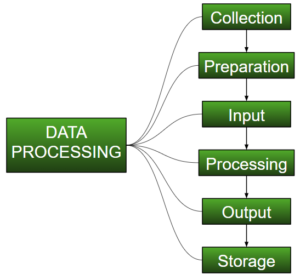Data Processing is a task of converting data from a given form to a much more usable and desired form i.e. making it more meaningful and informative. Using Machine Learning algorithms, mathematical modelling and statistical knowledge, this entire process can be automated. The output of this complete process can be in any desired form like graphs, videos, charts, tables, images and many more, depending on the task we are performing and the requirements of the machine. This might seem to be simple but when it comes to really big organizations like Twitter, Facebook, Administrative bodies like Paliament, UNESCO and health sector organisations, this entire process needs to be performed in a very structured manner. So, the steps to perform are as follows:

- Collection :
The most crucial step when starting with ML is to have data of good quality and accuracy. Data can be collected from any authenticated source like data.gov.in, Kaggle or UCI dataset repository.For example, while preparing for a competitive exam, students study from the best study material that they can access so that they learn the best to obtain the best results. In the same way, high-quality and accurate data will make the learning process of the model easier and better and at the time of testing, the model would yield state of the art results.
A huge amount of capital, time and resources are consumed in collecting data. Organizations or researchers have to decide what kind of data they need to execute their tasks or research.
Example: Working on the Facial Expression Recognizer, needs a large number of images having a variety of human expressions. Good data ensures that the results of the model are valid and can be trusted upon.
- Preparation :
The collected data can be in a raw form which can’t be directly fed to the machine. So, this is a process of collecting datasets from different sources, analyzing these datasets and then constructing a new dataset for further processing and exploration. This preparation can be performed either manually or from the automatic approach. Data can also be prepared in numeric forms also which would fasten the model’s learning.
Example: An image can be converted to a matrix of N X N dimensions, the value of each cell will indicate image pixel. - Input :
Now the prepared data can be in the form that may not be machine-readable, so to convert this data to readable form, some conversion algorithms are needed. For this task to be executed, high computation and accuracy is needed. Example: Data can be collected through the sources like MNIST Digit data(images), twitter comments, audio files, video clips. - Processing :
This is the stage where algorithms and ML techniques are required to perform the instructions provided over a large volume of data with accuracy and optimal computation. - Output :
In this stage, results are procured by the machine in a meaningful manner which can be inferred easily by the user. Output can be in the form of reports, graphs, videos, etc - Storage :
This is the final step in which the obtained output and the data model data and all the useful information are saved for the future use.
